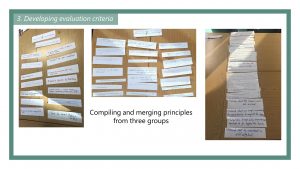The third seminar was all about the process of ELT materials evaluation. That is how could teachers both novice and in-service evaluate a coursebook. I must say that this seminar was of great benefit for me since I don’t usually get involved in the process of evaluating materials back home in Kuwait. I learned that th ere are frameworks and principles for novice teachers to follow in order to conduct a proper evaluation of ELT materials. Although I’m not a novice teacher, knowing that there are frameworks proposed by researcher like ( Tomlinson, 2013) and (McGrath, 2013) were greatly beneficial.
ere are frameworks and principles for novice teachers to follow in order to conduct a proper evaluation of ELT materials. Although I’m not a novice teacher, knowing that there are frameworks proposed by researcher like ( Tomlinson, 2013) and (McGrath, 2013) were greatly beneficial.
Based on the knowledge we gain from the seminar, our tutor Paul asked us to create our own framework and checklist for evaluating materials. We were put into groups and my group and I decided to meet in the library to prepare for the task.
Our group decided that the first thing to do was to make use of the already created lists of principled in the seminar. So, from the four groups A, B, C and D we decided to merge the first three ones into one list. We then chose the most appropriate principles from the list we created by omitting the ones we deemed unnecessary.
Regarding the approach we followed for the evaluation process, we followed (McGrath 2013:52) cyclical approach. This approach consists of three stages, pre-use, in-use and post use. However, we only decided to do the pre-use evaluation.
The next step was to place the chosen principles in the new list under universal criteria, and these criteria are adapted from (Tomlinson 2013: 40-43).
The criteria are:
• Universal
• Local
• Media-specific
• Content-specific
• Age-specific
By placing these new principles under these criteria, we have created a table of evaluation that also underwent a revision and changed the members of the group. We then converted the principles in the table into questions and added further criteria. Having done that, our attention then shifted to the process of weighting these criteria of evaluation.
We discussed several weighing methods and finally settled on a rating scale of 1 to 5 with one being poor and five being excellent.
I gained a lot from this experience. Th idea of following cer tain principles as a framework to evaluate ELT materials can be extremely beneficial for me as a teacher from Kuwait. Even though I’m not a novice teacher, but I believe that these principles and frameworks broaden my vision when I want to evaluate the materials I use with my learners.
tain principles as a framework to evaluate ELT materials can be extremely beneficial for me as a teacher from Kuwait. Even though I’m not a novice teacher, but I believe that these principles and frameworks broaden my vision when I want to evaluate the materials I use with my learners.
References:
McGrath, I (2013) Teaching Materials and Roles of EFL/ESL teachers: Practice and Theory : Bloomsbury.
Tomlinson, B. (2013) Developing Materials for Language Teaching (2nd ed.). London: Bloomsbury
Academic.


At this stage, I am looking at the blogs to see how people have approached them, and so that I can give feedback to everyone which allows them to make improvements to the blog should they wish to. What you have done is adequate and benefits from your posting up the results of your collaboration with other students in the group in the post. I don’t set a word length for posts because I expect the length of the posts to vary from week to week in line with students’ interests and pressure on their time. However, this post is a little on the short side. You could have reported your conclusions on ‘face2face’, and could have commented on Theresa Clementson’s contributions to the session. Do go back to the post to proofread it as there are some minor slips to sort out. – Paul